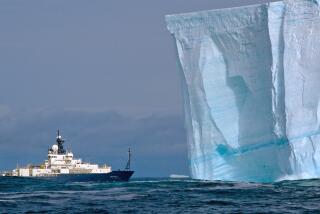Expedition marketing goes to extremes
- Share via
One campaign takes the high road, which will lead a team of celebs, do-gooders and hypoxia enthusiasts to the top of Mt. Kilimanjaro, in Tanzania, to raise awareness of the global clean-water crisis. The other takes the low road, descending to the lowest point on Earth, the Mariana Trench, near Guam, and then sinks even lower in a cheesy attempt to sell cars.
Yet both promotional efforts suggest a trend in what might be called expedition marketing. This is the era of Discovery Channel-style, extreme adventure entertainment -- Bear Grylls living off spiders in the Kalahari, Matt Watson jumping from a helicopter onto a sailfish, great races hither and yon. And causes and companies seem to be ever more willing to go to the ends of the Earth to get attention back home.
On Jan. 7, an expedition sponsoredby Hewlett-Packard will set out for the icy caldera atop Kilimanjaro, at 19,340 feet the highest point in Africa. The Summit on the Summit project was the idea of Ethiopian-born American musician Kenna, whose father had suffered from water-borne illness as a child. Joining Kenna on the mountain will be 14 other team members, including certified A-lister Jessica Biel, hip-hop artist Lupe Fiasco, actor Isabel Lucas, clean-water activist Alexandra Cousteau (granddaughter of Jacques) and Kick Kennedy (daughter of environmental activist Robert F. Kennedy Jr.).
Mountaineering enthusiasts will recognize the name Jimmy Chin, legendary alpine adventure photographer, for whom the slog up Kilimanjaro will feel like a speed bump.
In support of the event, HP is running 30- and 60-second commercials to drive viewers to the project’s Web portal (www.summitonthesummit.com). There, users can learn more about the water crisis, donate to the cause, sponsor a foot of the climb, tweet the climbers and buy some of the affiliate sponsors’ gear (First Ascent by Eddie Bauer, PUR water filters). The website also includes a graphical altitude scale on which users can click to get updates from the teams, including tweets, blogs and video clips.
HP will equip climbers with its Light and Thin notebook computers to handle the social media tasks, while the base camp will be fitted with high-power HP desktops and media servers.
This is by no means the first time a tech company has sponsored a climb. Dell, Apple and Microsoft have all been to the top of Everest, along with a lot of other Fortune 500 brand names. But with its constant, boots-on-the-ground updating, this might be the most socially mediated climb ever attempted. As such, it’s brilliant positioning for HP and Windows,which are waging a war of cultural attrition against the presumably hipper, younger, more social Mac.
Also feeling a cool breeze at its back is First Ascent by Eddie Bauer, which is a new line of expedition gear to compete with the likes of Patagonia, North Face and Marmot. Eddie Bauer -- long consigned to mall-bought, flannel shirt ignominy -- suddenly seems a lot more relevant in the outerwear category.
The Summit on the Summit effort is a beautifully constructed piece of cause-related marketing, not least because of its exotic venue. The glacier on Kilimanjaro has shrunk dramatically in the last century and, while there’s debate about the proximate cause (climate change vs. declining humidity due to surrounding deforestation), there’s little doubt about other glaciers’ around the world disappearing and taking the local melt-water hydrology with them. The mountain is an icon of the larger cause, and HP does well to be a part of it.
Meanwhile, some 55,541 feet below the summit of Kilimanjaro, there rests another monument to marketing adventure, sort of.
At some point in the last year -- the timing isn’t exactly clear, though the video was posted Dec. 22 -- Alfa Romeo of Belgium supposedly lowered a large steel-and-plastic billboard to the bottom of the Mariana Trench, at a depth of more than 36,000 feet, the lowest point on Earth. The effort, called Alfa Romeo Expedition 147, was intended to dramatize the lowest possible prices on the Alfa 147. The sign reads: “We can’t go any lower.” Too true.
The project, the work of agency Duval Guillaume, is semi-seriously documented in a six-minute, viral-only video posted on YouTube, which lauds the work of a “unique team of explorers.”
“We needed a campaign that really pushed the limits; so if this is the lowest price possible for an Alfa Romeo, then maybe we should place the poster at the lowest place possible,” says Geoffrey Hantson, creative director at Duval Guillaume.
It’s not particularly important to determine whether the video is a hoax or not. Whether Alfa Romeo Belgium did or didn’t throw this monstrous piece of trash into the ocean, it has trivialized the problem of ocean pollution.
What’s interesting is the use of the Mariana as a geologic prop, and it’s hard not to see the symbolism of these global extremes, the most inaccessible places on the planet, gradually succumbing to the predations of advertising and marketing.
Perhaps apropos of its global footprint, Coca-Cola has set out to make the whole world its expedition. On Jan. 1, in Madrid, three young people -- “happiness ambassadors” -- will embark on Coca-Cola’s yearlong Expedition 206, visiting all 206 countries in the world where Coke is sold in an effort to find what makes people happy (wanna bet it’s Coke?).
This expedition too will be wired, with constant updating on Facebook, Flickr, Twitter and the event’s portal ( www.expedition206.com). And considering some of the places Coke is sold -- Yemen, Rwanda, Myanmar come to mind -- the ambassadors should have a fairly exciting trip.
Stay tuned. Coca-Cola is betting you will.
More to Read
Sign up for The Wild
We’ll help you find the best places to hike, bike and run, as well as the perfect silent spots for meditation and yoga.
You may occasionally receive promotional content from the Los Angeles Times.






